A simple route to prepare a Cu2O–CuO–GN nanohybrid for high-performance electrode materials†
Abstract
Cu2O–CuO–GN nanohybrid is prepared by a simple electrochemical method by applying a positive and negative pulse electric signal on a dispersion of a mixture of GO and Cu(NO3)2. During the process, reduction of graphene oxide and deposition of Cu2O–CuO on GN occur simultaneously. The nanohybrid is systematically characterized by X-ray diffraction (XRD), X-ray photoelectron spectroscopy (XPS), scanning electron microscopy (SEM) and transmission electron microscopy (TEM). Cu2O–CuO nanoparticles with diameters around 100 nm are uniformly distributed on the GN. In addition, the electrochemical properties of the Cu2O–CuO–GN nanohybrid are investigated by cyclic voltammetry (CV), galvanostatic charge/discharge (DC) and electrochemical impedance spectrometry measurements (EIS). The Cu2O–CuO–GN nanohybrid shows a higher specific capacitance (222 F g−1 at 1 A g−1) than that of pure GN (143 F g−1 at 1 A g−1) prepared under the same conditions. This approach opens up the possibility for fabrication of high-performance GN-based electrode materials.



 Please wait while we load your content...
Please wait while we load your content...